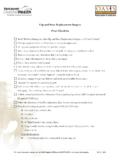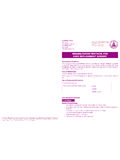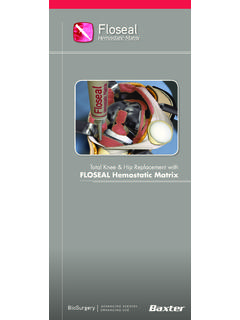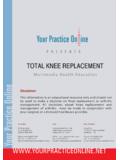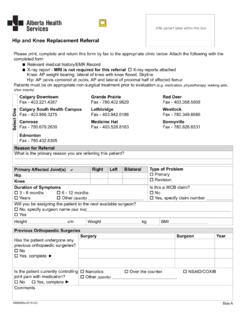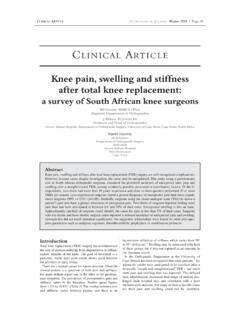Transcription of Hip Replacement Surgery - Grand River …
1 Exercise Guide for Hip Replacement Surgery Please bring this guide to the hospital and to all physiotherapy appointmentsName:_____Surgery Date:_____Surgeon:_____Special Instructions:_____ _____Acknowledgments This edition of the guide would not have been possible without the tireless efforts and dedication of the sub-committee of the Provincial Rehab Advisory Group (PRAG) and contributions made by physiotherapists in the following Health Authorities:The original book was produced in 2005. We would like to acknowledge the original contributions made by:The Mary Pack Arthritis Program, Sunshine Coast, Powell River , Vancouver Hospital and Richmond would also like to thank the joint Replacement clients, surgeons, physicians and other health care professionals who participated in the evaluation and revision process of this guide.
2 Your feedback and suggestions will be of great help to those preparing for joint Replacement Health AuthorityInterior Health AuthorityNorthern Health AuthorityVancouver Island Health AuthorityVancouver Coastal Health AuthorityProvidence Health CarePlease refer to the Before During and After Hip and Knee Replacement Surgery A Patient s Guide for further guide is available at: exercises prescribed, and the pace of progressions recommended in the hip exercise booklet, are intended for patients with unilateral, primary hip Replacement for osteoarthritis, with a postero-lateral incision approach. These exercises may be suitable for patients with a different surgical approach, bilateral total hip replacements, revisions or for inflammatory conditions. However, progressions and recovery may be slower. Some exercises will need to be modified to suit the individual patient by the clinician.
3 The exercises are designed to be prescribed by a Surgery : General Guidelines ..3 Learn to Turn On Core Muscles ..4 Before Surgery : Exercises ..5 After Surgery : General Guidelines ..6 What to Expect: Weeks 0 3 ..7 Exercises: Weeks 0 3 ..8 What to Expect: Weeks 3 6 ..15 Exercises: Weeks 3 6 ..16 What to Expect: Weeks 6 9 ..21 Exercises: Weeks 6 9 ..22 What to Expect: Weeks 9 12 ..26 Exercises: Weeks 9 12 ..27 Exercise Guidelines: 3 Months 1 Year ..33 Leisure and Sports After Total Hip Replacement (THR) ..37 Helpful Resources ..38 Community Exercise Programs After THR ..39 Exercise are about to have hip Replacement Surgery . People who prepare for Surgery and take an active role in their care can recover in less time and with less pain. This guide has general information along with tips and goals for exercising before and after Surgery .
4 The goals and exercises in this guide will help you along the path to recovery. The instructions from your surgeon, doctor or physiotherapist may be slightly different than in this booklet. Always follow the directions of your health care starting any exercise program check with your physiotherapist or doctor. This guide is to be used under the direction of your :If you have too much pain in your hip to exercise, or if any of the exercises cause more pain, swelling or bruising in your hip, stop. Tell your physiotherapist or Surgery 3 Before Surgery : General GuidelinesRegular exercise before Surgery can help your recovery. Exercise also helps to: Keep the movement in your hip Make your muscles strong Control your pain Build your knowledge of how to exercise after Surgery Reduce your body weight Improve your sleep Do activities that put less stress on your hip.
5 Try: Swimming, water walking, water aerobics Upright stationary cycling Walking with or without poles Strengthening or stretching exercises ( pages 9 15 in this booklet)Warm up before doing strengthening or stretching exercises. Walk for 5 10 minutes Use an upright stationary bike for 5 10 minutes Apply moist heat to tight or stiff muscles for 5 10 minutesTo keep pain under control: Rest your joint for short, frequent times in the day Pace yourself Use a walking aid such as a cane, walking poles or walker Talk to your doctor or pharmacist about pain medicine4 Before SurgeryLearn to Turn On Your Core MusclesCore muscles are deep muscles that support your spine and pelvis. They provide stability, control and good posture when you move. When your hip hurts too much to stand or walk, these muscles become weak and don t work well.
6 This can lead to back pain, stiff back, stiff hips, and poor balance. With practice, they will turn on without you thinking about to turn on these muscles before and during each exercise. 1a. Pelvic floor (bladder muscles) Pull your bladder muscles to your belly button OR imagine you are gently trying to hold your urine. Hold for 6 seconds, then slowly relax Repeat 6 8 times, 3 times a day1b. Lower abdominal muscles Pull your belly button into your spine OR imagine slowly zipping up a tight pair of pants. Hold for 6 seconds while breathing quietly, then slowly relax as if you unzip your pants. Keep upper chest relaxed Repeat 6 8 times, 3 times a day Vancouver Coastal HealthBefore Surgery 5 Before Surgery : Exercises2. Arm chair push-upsYou need strong arms to use your walker (or crutches) and to help you get out of bed.
7 Strengthen your arms before your Surgery . Sit on chair with armrests Place hands on armrests with elbows bent Push down through your hands to lift your body off the seat Hold 6 seconds, slowly lower down Repeat 8 15 times, 3 times a weekDo the following exercises from this guide: Turn on core muscles (page 4)Range of motion exercises Leg slide out (8.) Hip stretches (9.)Strengthening exercises Knee straightening (7.) Hip lift (bridge) (12.)Stretching exercises Hamstring stretch (10.) Calf stretch (11.) Thigh stretch on belly (19.) Vancouver Coastal Health6 After SurgeryAfter Surgery : General guidelinesExercise after Surgery will help you recover and regain movement and strength in your hip. Exercise also helps to: Reduce swelling Improve sleep Prevent blood clots Improve balance Control pain Increase activity tolerance Prevent constipationHip precautionsAfter Total Hip Replacement (THR) you will need to follow hip precautions for 3 months unless your surgeon tells you differently.
8 These precautions help you heal and reduce risk of hip dislocation. It is important that you understand and follow these precautions. Read them in Before, During and After Hip and Knee Replacement Surgery . Ask your surgeon for a copy or go online at controlSuggestions to keep pain under control are in the booklet Before, During and After Hip and Knee Replacement Surgery mentioned your whole leg becomes swollen, warm or increasingly painful, tell your doctor right may have muscle pain as you begin new exercises or return to work. If the increased pain lasts into the next day, try spending less time standing and reduce your exercises. Each person heals differently. The time it takes to meet goals may differ. Talk to your surgeon or physiotherapist if you are concerned. Weeks 0 3 7 What to Expect: Weeks 0 3 Follow suggestions to keep your pain under control in the early days after Surgery .
9 This reduces your chance of long term pain and helps you to move more freely. Get enough sleep and maintain regular bowel movements. In the first 3 weeks, exercises focus on hip movement and gradually increasing your standing and : By the end of week 3 Move your leg in and out of bed by yourself (start with a strap) Move on and off a raised chair, bed and toilet without help Walk at home using a walker, cane or crutches Use the stairs safely with cane or crutches8 Weeks 0 3 Exercises: Weeks 0 33. Foot and ankle pumpThis helps to reduce swelling and risk of blood clots Pump your whole foot up and down Repeat 10 times, every hour4. Breathing Sit with shoulders relaxed Turn on core muscles (page 4) Breathe in slowly through your nose, feel your ribcage widen sideways (core muscles are on) Breathe out slowly and feel your ribcage drop down Repeat 6 breaths, every hour5.
10 Core heel slide Lie on your back with knees bent, feet in line with shoulders Turn on core muscles (page 4) to keep back and pelvis still Slide one leg down the bed, re-set your core muscles, slide leg back up Repeat 6 8 times, 3 times a day Repeat on other side Vancouver Coastal Health Vancouver Coastal Health Vancouver Coastal HealthWeeks 0 3 96. Lower buttock squeeze6a. Lying Lie on your back with legs straight Squeeze lower buttocks together gently, as if holding a pencil between your buttocks Hold 6 seconds Repeat 6 8 times, 3 times a day6b. Sitting Sit on chair with feet supported, hands under your sit bones Turn on core muscles Squeeze lower buttock muscles together, feeling your sit bones pull away and lift off your fingers (imagine sitting on a hot leather seat) Hold 6 seconds, slowly relax, as you keep core muscles on Repeat 6 - 8 times, 3 times a day7.
